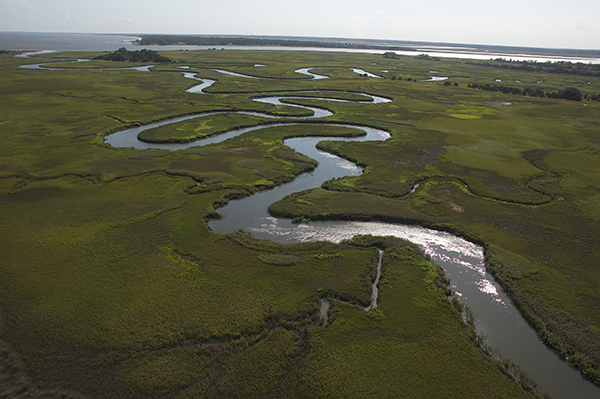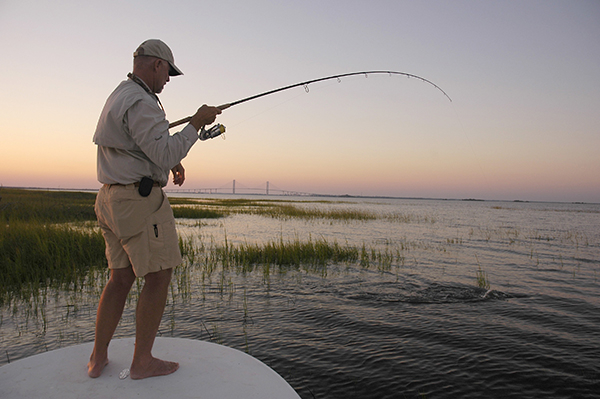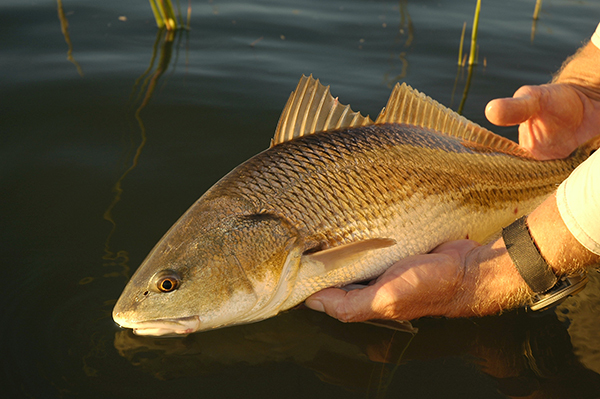Driving over the nearly 500-foot-high Sidney Lanier Bridge that anchors southeast Georgia’s Golden Isles, you scan a vast watery world crisscrossed by vibrant saltmarsh. Impossibly green in summer, the patchwork system of Spartina islets and meandering creeks glows like molten gold during an autumn dawn.
Boaters who happen upon this overlooked low-country destination often can’t believe their luck. The region features the mainland city of Brunswick and four barrier islands — St. Simons, Sea, Jekyll, and the privately owned Little St. Simons. Motor up to a longshore sandbar or idle through the backcountry mid-week and you might find incomparable solitude.
You’ll also find some tricky tides and currents. Nestled in the middle of the South Atlantic Bight, a drastic inland curvature in the coast, the Golden Isles floods on a high tide like the bottom of a funnel. Ocean water pours through the region’s four inlets with vigor, creating two low and two high tides each day that reach amplitudes of 6 to 9 feet. Currents ramp up and their movement stirs the pluff-mud substrate.

Planning a boating or fishing outing in this coastal delta means first checking the tide tables, and second, knowing your boat’s actual draft. Take note: Strong winds can also hold water in or push it out of the bays and creeks.
The strong tides certainly affect launching and retrieving at any of the area’s seven public ramps. If your boat comes equipped with heavy-duty lifting eyes, you can visit one of the three marinas that offer hoist services: Blythe Island Regional Park, Two-Way Fish Camp, and St. Simons Boating and Fishing Club.
Where you launch depends upon how you plan to enjoy your Golden Isles outing. Anglers, who might target inshore species such as trout and redfish, explore the creeks and the marsh shorelines. For coastal species such as tripletail, Spanish mackerel and tarpon, hunt the beaches and inlets.
When fishing the estuary, be aware of oyster reefs that often jut from the marsh points into the sound. Easy to see at low tide, these rock-hard redfish magnets can rough up your fiberglass.
Whether fishing or exploring, be sure to proceed slowly, run sonar and study your electronic charts. If you own a chart plotter that comes with community-provided information, be sure to turn on that layer to see what navigation info the locals have added.
Check with the tackle shops or book a half-day charter to find out more about fishing options. The Golden Isles’ Convention and Visitor’s Bureau offers listings.
Explorers find rich history and beautiful scenery throughout the region. While Georgia features only 100 miles of actual coastline, it hosts 368,000 acres of estuarine tidal marsh. Two major rivers — the Satilla and the Altamaha — feed the Golden Isles marshes.
During the 18th and 19th centuries, rice plantations thrived along the waterways. In some locations, such as the Satilla River just upstream of Woodbine, pilings overtopped by wild plants and flowers mark the historic docks and loading areas.

Motor along the Intracoastal Waterway on the back side of Jekyll Island, and you’ll find a one-time playground of the rich and richer. During the late 1800s and early 1900s, families such as the Vanderbilts, Pulitzers, Rockefellers and Morgans built their winter “cottages” — typically two-story mansions — clustered around the Jekyll Island Club.
Dock at the club or the nearby Jekyll Harbor Marina and walk through the historic district, then eat at The Wharf or Zachry’s Riverhouse. You’ll also find waterfront dining at Coastal Kitchen at St. Simons’ Morningstar Marina, and at Mudcat Charlie’s on the Altamaha River to the north.
Head to Mudcat’s via the Frederica River to see a remnant of Fort Frederica, established in 1736 by British General James Oglethorpe.
To experience 11,000 acres of true coastal wildness, head east toward the Hampton River Marina. Tuck the boat into a dock space and take a ferry across the river to Little St. Simons Island for a day or overnight experience. The lodge hosts guided excursions and offers garden-to-table cuisine.
If your boating wishlist includes tubing, swimming or watersports, remember that the currents can be quick. Find areas in the rivers that offer long runs in wide channels over deep water with ample areas to turn.

When it’s time to slow the pace, pick a sandbar or ICW-side beach and enjoy a picnic lunch. Know that Georgia law requires boaters to move at idle speed within 100 feet of a beach, so throttle back.
When you beach your boat, remember to set a spare anchor aft in case you need to pull yourself to deeper water. If you like to walk the shorelines, keep your eyes open for shark’s teeth as well as seashells.
Be aware that shorelines rimmed by marsh grass often feature gray, quicksandlike mud. Step overboard to wade ashore, and you’ll likely lose your shoes. However, marsh-grass areas can be a great place to watch wading birds, and they often signal the presence of baitfish to anglers.
Whatever your on-water getaway goals might be, the Georgia low-country can provide a unique experience you can’t get at more mainstream locations. Just remember to pack your boating skills and respect the tides.
Back to Blue Life
Boaters who happen upon this overlooked low-country destination often can’t believe their luck. The region features the mainland city of Brunswick and four barrier islands — St. Simons, Sea, Jekyll, and the privately owned Little St. Simons. Motor up to a longshore sandbar or idle through the backcountry mid-week and you might find incomparable solitude.
You’ll also find some tricky tides and currents. Nestled in the middle of the South Atlantic Bight, a drastic inland curvature in the coast, the Golden Isles floods on a high tide like the bottom of a funnel. Ocean water pours through the region’s four inlets with vigor, creating two low and two high tides each day that reach amplitudes of 6 to 9 feet. Currents ramp up and their movement stirs the pluff-mud substrate.

Planning a boating or fishing outing in this coastal delta means first checking the tide tables, and second, knowing your boat’s actual draft. Take note: Strong winds can also hold water in or push it out of the bays and creeks.
The strong tides certainly affect launching and retrieving at any of the area’s seven public ramps. If your boat comes equipped with heavy-duty lifting eyes, you can visit one of the three marinas that offer hoist services: Blythe Island Regional Park, Two-Way Fish Camp, and St. Simons Boating and Fishing Club.
Where you launch depends upon how you plan to enjoy your Golden Isles outing. Anglers, who might target inshore species such as trout and redfish, explore the creeks and the marsh shorelines. For coastal species such as tripletail, Spanish mackerel and tarpon, hunt the beaches and inlets.
When fishing the estuary, be aware of oyster reefs that often jut from the marsh points into the sound. Easy to see at low tide, these rock-hard redfish magnets can rough up your fiberglass.
Whether fishing or exploring, be sure to proceed slowly, run sonar and study your electronic charts. If you own a chart plotter that comes with community-provided information, be sure to turn on that layer to see what navigation info the locals have added.
Check with the tackle shops or book a half-day charter to find out more about fishing options. The Golden Isles’ Convention and Visitor’s Bureau offers listings.
Explorers find rich history and beautiful scenery throughout the region. While Georgia features only 100 miles of actual coastline, it hosts 368,000 acres of estuarine tidal marsh. Two major rivers — the Satilla and the Altamaha — feed the Golden Isles marshes.
During the 18th and 19th centuries, rice plantations thrived along the waterways. In some locations, such as the Satilla River just upstream of Woodbine, pilings overtopped by wild plants and flowers mark the historic docks and loading areas.

Motor along the Intracoastal Waterway on the back side of Jekyll Island, and you’ll find a one-time playground of the rich and richer. During the late 1800s and early 1900s, families such as the Vanderbilts, Pulitzers, Rockefellers and Morgans built their winter “cottages” — typically two-story mansions — clustered around the Jekyll Island Club.
Dock at the club or the nearby Jekyll Harbor Marina and walk through the historic district, then eat at The Wharf or Zachry’s Riverhouse. You’ll also find waterfront dining at Coastal Kitchen at St. Simons’ Morningstar Marina, and at Mudcat Charlie’s on the Altamaha River to the north.
Head to Mudcat’s via the Frederica River to see a remnant of Fort Frederica, established in 1736 by British General James Oglethorpe.
To experience 11,000 acres of true coastal wildness, head east toward the Hampton River Marina. Tuck the boat into a dock space and take a ferry across the river to Little St. Simons Island for a day or overnight experience. The lodge hosts guided excursions and offers garden-to-table cuisine.
If your boating wishlist includes tubing, swimming or watersports, remember that the currents can be quick. Find areas in the rivers that offer long runs in wide channels over deep water with ample areas to turn.

When it’s time to slow the pace, pick a sandbar or ICW-side beach and enjoy a picnic lunch. Know that Georgia law requires boaters to move at idle speed within 100 feet of a beach, so throttle back.
When you beach your boat, remember to set a spare anchor aft in case you need to pull yourself to deeper water. If you like to walk the shorelines, keep your eyes open for shark’s teeth as well as seashells.
Be aware that shorelines rimmed by marsh grass often feature gray, quicksandlike mud. Step overboard to wade ashore, and you’ll likely lose your shoes. However, marsh-grass areas can be a great place to watch wading birds, and they often signal the presence of baitfish to anglers.
Whatever your on-water getaway goals might be, the Georgia low-country can provide a unique experience you can’t get at more mainstream locations. Just remember to pack your boating skills and respect the tides.
